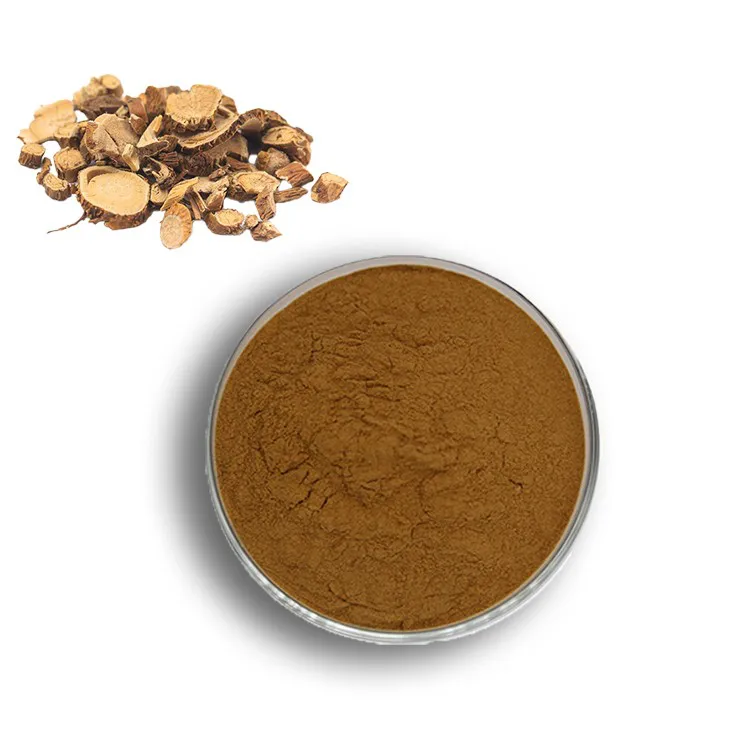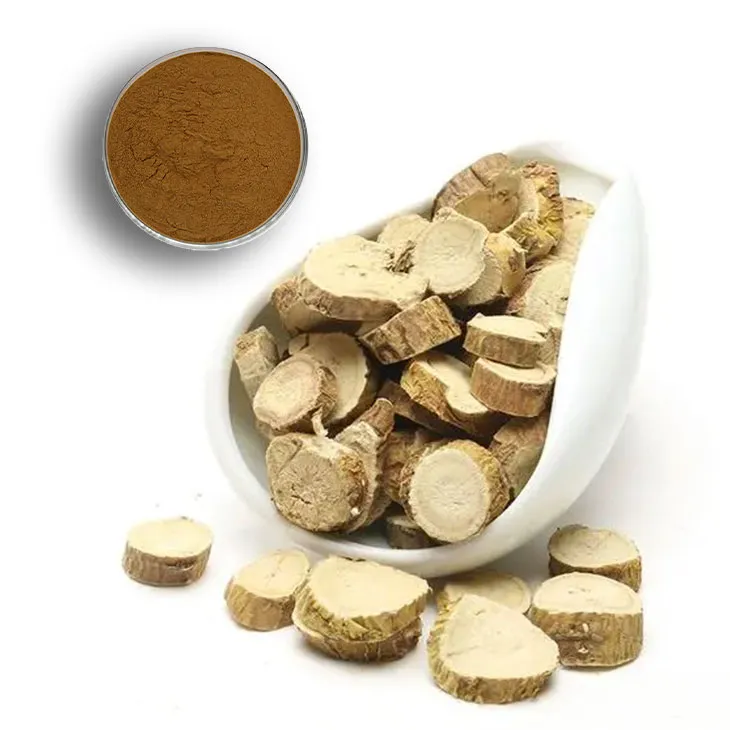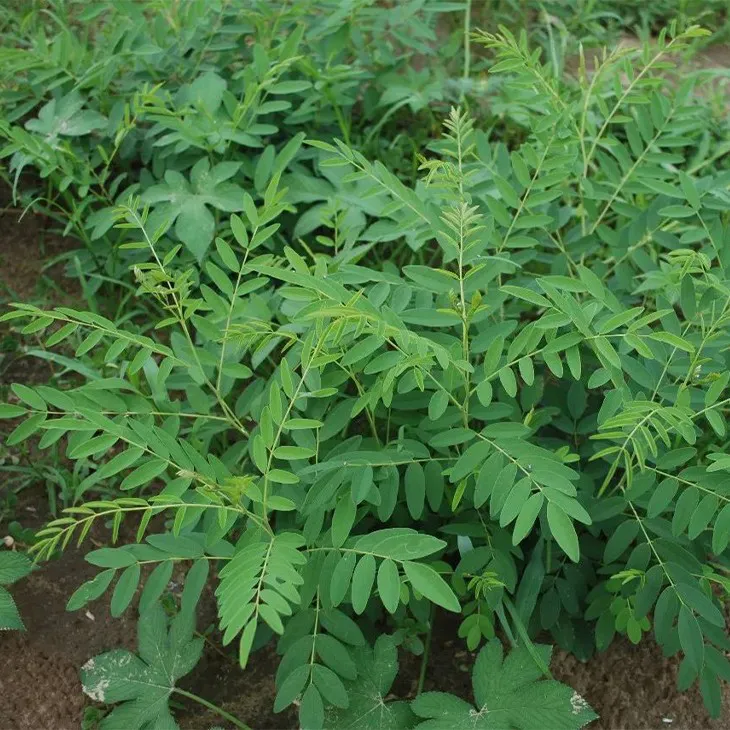- 0086-571-85302990
- sales@greenskybio.com
Sophora flavescens Root Extract: Nature's Best - Kept Secret.
2024-11-12

Introduction
The Kushen root, also known as Sophora flavescens, has been a part of traditional medicine for centuries. Its extract, the Kushen root extract, is a natural substance that holds a wealth of potential which is still being explored today. This extract is derived from the roots of the Kushen plant, which is native to certain regions in Asia. Despite its long - standing use in traditional medicine, it remains relatively unknown in the broader context of modern medicine and natural remedies.

The Origins of Kushen Root
The Kushen plant is typically found in areas with specific environmental conditions. It thrives in regions with well - drained soil and a particular climate. The roots are carefully harvested following traditional methods that have been passed down through generations. These methods ensure that the root is collected at the optimal time for maximum potency. In traditional medicine systems, such as Traditional Chinese Medicine (TCM), the Kushen root has been highly regarded for its various properties.

Traditional Medicinal Uses
Treating Infections
In traditional medicine, Kushen root extract has been used to combat infections. It was believed to have antimicrobial properties that could help the body fight off harmful bacteria, viruses, and fungi. For example, in some historical medical records, it was used to treat skin infections by applying a poultice made from the root extract directly to the affected area. The knowledge of such uses was passed on orally and through written medical texts in traditional medical communities.
Anti - Inflammatory Effects
Another significant traditional use of Kushen root extract was for its anti - inflammatory properties. It was used to reduce swelling and pain in various parts of the body. For instance, in cases of joint inflammation or muscle soreness, preparations containing Kushen root extract were administered either topically or orally. This anti - inflammatory effect was thought to be due to certain bioactive compounds present in the extract.

Bioactive Compounds in Kushen Root Extract
Alkaloids
The Kushen root extract contains alkaloids, which are one of the main groups of bioactive compounds responsible for its medicinal properties. Matrine and oxymatrine are two important alkaloids found in the extract. These alkaloids have been the subject of numerous scientific studies due to their potential pharmacological activities. They are believed to play a role in the anti - inflammatory and antimicrobial effects of the Kushen root extract. For example, in vitro studies have shown that matrine can inhibit the growth of certain bacteria by interfering with their metabolic processes.
Flavonoids
Flavonoids are also present in Kushen root extract. These compounds are known for their antioxidant properties in many plants. In the case of Kushen root, flavonoids may contribute to its overall health - promoting effects. They can scavenge free radicals in the body, which are harmful molecules that can cause damage to cells and tissues. By reducing oxidative stress, flavonoids in the Kushen root extract may help prevent various diseases and support the body's natural defense mechanisms.
Modern Research on Kushen Root Extract
Anti - Inflammatory Mechanisms
Modern scientific research has delved deeper into the anti - inflammatory mechanisms of Kushen root extract. It has been found that the extract can modulate the body's immune response by regulating the production of inflammatory cytokines. Cytokines are small proteins that play a crucial role in the immune system's response to inflammation. By inhibiting the over - production of certain pro - inflammatory cytokines, Kushen root extract can help reduce inflammation. For example, in animal models of arthritis, treatment with Kushen root extract has shown a significant reduction in joint inflammation compared to control groups.
Antimicrobial Activity
Regarding antimicrobial activity, researchers have used advanced laboratory techniques to study the effectiveness of Kushen root extract against a wide range of microorganisms. The extract has shown promising results against drug - resistant bacteria, which is a significant concern in modern medicine. Studies have demonstrated that the alkaloids in the extract can disrupt the cell membranes of bacteria, leading to their death. This makes Kushen root extract a potential candidate for the development of new antimicrobial agents.
Potential Applications in Cosmetics
Skin Health
Due to its anti - inflammatory and antimicrobial properties, Kushen root extract has potential applications in the cosmetics industry. It can be used in skincare products to treat acne - prone skin. The antimicrobial activity can help kill the Propionibacterium acnes bacteria, which are often associated with acne. Additionally, the anti - inflammatory effect can reduce the redness and swelling associated with acne breakouts. It can also be used in anti - aging products as the antioxidant properties of the flavonoids in the extract can help protect the skin from oxidative damage, which is one of the main causes of premature aging.
Hair Care
In hair care, Kushen root extract may have benefits as well. It can be used to treat scalp conditions such as dandruff. The antimicrobial properties can combat the Malassezia fungus, which is often linked to dandruff. Moreover, the extract may also promote hair growth by improving the health of the scalp. By reducing inflammation and providing nourishment to the hair follicles, it has the potential to enhance hair growth and thickness.
Challenges in Utilizing Kushen Root Extract
Standardization
One of the major challenges in using Kushen root extract is standardization. The composition of the extract can vary depending on factors such as the origin of the plant, the harvesting time, and the extraction method. This makes it difficult to ensure consistent quality and potency in products containing the extract. For example, different batches of Kushen root extract may have different levels of alkaloids or flavonoids, which can affect its efficacy. Standardization efforts are needed to develop reliable quality control methods.
Safety and Toxicity
Although Kushen root extract has a long history of use in traditional medicine, its safety and toxicity in modern applications need further investigation. Some studies have suggested that high doses of certain compounds in the extract may have adverse effects. For instance, excessive consumption of alkaloids may cause liver toxicity in some cases. Therefore, more research is required to determine the safe dosage range and potential side effects of Kushen root extract.
Future Prospects
Pharmaceutical Developments
With the increasing understanding of the pharmacological properties of Kushen root extract, there is potential for the development of new pharmaceutical drugs. Scientists are exploring ways to isolate and purify the active compounds in the extract for more targeted drug development. For example, the alkaloids could be modified to enhance their effectiveness against specific diseases. This could lead to the creation of novel drugs for treating inflammatory diseases or infections.
Natural Health Product Market
The natural health product market is also likely to see an increase in products containing Kushen root extract. As consumers become more interested in natural remedies, there is a growing demand for products that utilize the beneficial properties of plants like Kushen. However, to meet this demand, companies need to address the challenges of standardization and safety. By doing so, they can develop high - quality products that can gain wider acceptance in the market.
Conclusion
Kushen root extract is truly a nature's best - kept secret. It has a rich history in traditional medicine and is now showing great potential in modern applications. Despite the challenges, the future looks promising for the further exploration and utilization of this extract. With continued research, it has the potential to make significant contributions to various fields such as medicine, cosmetics, and the natural health product industry.
FAQ:
What is Kushen root extract?
Kushen root extract is an extract derived from the Kushen root. It has unique properties and has been used in traditional medicine for a long time.
What are the traditional uses of Kushen root extract?
It has been used in traditional medicine for centuries, though specific traditional uses can vary. It may have been used for treating various ailments within the framework of traditional medical systems.
What are the potential modern applications of Kushen root extract?
Some of the potential modern applications include anti - inflammation and anti - microbial uses, but there is still much more of its potential waiting to be fully explored in modern medicine.
How is Kushen root extract obtained?
The extract is obtained from the Kushen root. However, the exact extraction process can be complex and may involve different techniques such as solvent extraction, but specific details often depend on the research and production methods.
Are there any side effects of Kushen root extract?
At present, while it has shown potential benefits, more research is needed to fully understand any possible side effects. As with any substance, there could be potential risks depending on factors like dosage, method of use, and individual differences.
Related literature
- The Pharmacological Properties of Sophora Flavescens Root Extract"
- "Sophora Flavescens Root Extract: Traditional and Modern Perspectives"
- "Uncovering the Mysterious Benefits of Kushen Root Extract"
- ▶ Hesperidin
- ▶ Citrus Bioflavonoids
- ▶ Plant Extract
- ▶ lycopene
- ▶ Diosmin
- ▶ Grape seed extract
- ▶ Sea buckthorn Juice Powder
- ▶ Fruit Juice Powder
- ▶ Hops Extract
- ▶ Artichoke Extract
- ▶ Mushroom extract
- ▶ Astaxanthin
- ▶ Green Tea Extract
- ▶ Curcumin
- ▶ Horse Chestnut Extract
- ▶ Other Product
- ▶ Boswellia Serrata Extract
- ▶ Resveratrol
- ▶ Marigold Extract
- ▶ Grape Leaf Extract
- ▶ New Product
- ▶ Aminolevulinic acid
- ▶ Cranberry Extract
- ▶ Red Yeast Rice
- ▶ Red Wine Extract
-
Peppermint Extract Powder
2024-11-12
-
Hawthorn powder
2024-11-12
-
Avocado Extract Powder
2024-11-12
-
Curcuma Longa Extract/Turmeric extract
2024-11-12
-
Scutellaria Extract
2024-11-12
-
Black Garlic Extract
2024-11-12
-
Centella Asiatica Extract
2024-11-12
-
Sea buckthorn Juice Powder
2024-11-12
-
Fenugreek Extract Powder
2024-11-12
-
Hawthorn Extract
2024-11-12





















